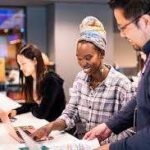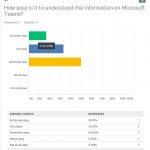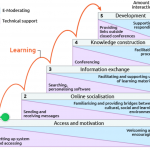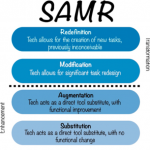How can digital technologies engage a diverse range of learners?
Portfolio – Using Digital Technologies
Figure 1. Torrens University students (Torrens University Australia, 2020)
The traditional pedagogies, where a teacher is often at the front of the classroom, are increasingly being complemented by other teaching methods for instance an Androgogical approach, by which Knowles (1984) emphasizes that adults are self-directed and expect to take responsibility for their decisions.
In conjunction to this, a Heutagogical approach to teaching and learning (Kenyon & Hase, 2010) applies technologies in online teaching, as a tool for guiding online learning practice, whereby online teachers develop and deliver course content using 21st century skills and tools. For instance, social media which is the forefront of the digital age, particularly now due to these unprecedented times of COVID-19, where institutions are diverting face to face classrooms to an online format.
Furthermore, the web is a very important tool in the online teaching forum and if we look at the ever evolving wide world web from its first inception Web 1.0, was a readable portal of information, where users passively receive information. Dissimilar to Web 1.0, Web 2.0 assists with interacting between online student users and different web platforms, allowing students to work together more easily with one another to encourage participation, collaboration, and information sharing (McCall & Kim, 2014). As a future teacher, this can be achieved by the Learning Management System (LMS) such as Blackboard or YouTube, Wiki and social networking in the classroom, such as discussion forum or chat rooms.
In stating this, I can incorporate these approaches into my teaching context and when used successfully, these approaches can promote Connectivism model (Siemens, 2005) in the online platform, encouraging students to be involved in networks such as using the internet, metacognition skills, a Community of Practice (CoP), identifying goals through the CoP and learn to integrate informal learning with their formal education.Therefore, when looking at the learning context, teachers and students can use digital tools for developing their critical thinking and problem-solving skills.
In addition, collaborating with fellow peers in a CoP via an interactive digital platform such as Zoom group or Microsoft Teams group, where students discuss their relevant experiences and challenges that they have faced, bouncing ideas and learning from one another. In this instance, as an online teacher I would reduce my responsibility to deliver all of the information for learning, but will maintain an integral role as a guide and teacher of learning.
In this folio, I will discuss my views on subject learning outcomes (SLO) and how as future teacher I would incorporate digital tools to assist with the learning outcomes. Consequently, I explored various digital platforms that I have never used before such as Kahoot, but found SurveyMonkey which is a great platform for digital tools for implementing the course SLO and also integrates with the clinics current digital platform Microsoft Teams (SurveyMonkey, 2020), in turn benefits and aligns with the SLO.
How I would have previously addressed the Learning Outcome
My focus will be based on the Integrative Complementary Medicine 2 (CAM407A), course outline which is part of the Bachelor of Health Science for Naturopathy, Western Herbal Medicine & Nutrition (Torrens University, 2017). This is a problem based learning subject, where the teacher facilitates clinical cases drawing upon research and clinical facts. Subsequently, each week students will review the integrative, holistic, approach to the treatment of specific body systems and then apply and integrate knowledge and analyse complex cases determining treatment plans, by means of herbal liquids, nutritional supplements and dietary plans.
The mode of teaching for this subject is face to face. Furthermore, students critically appraise literature regarding a clinical condition and therapeutic intervention and teachers provide e-journals, PowerPoints and soft copy documents for students to use. Students look at case studies, individual case work analysis and discuss in class. Lastly, discussion board is used by students to make an evidence based response to practice based critical thinking questions (Torrens University, 2017).
Subject Learning Outcome (SLO)
I will be looking at two of the four subject learning outcomes (SLO) for this folio and I will focus on the following; Integrate contemporary research into the development of relevant treatments; Discriminate between various treatment approaches to determine the most appropriate clinical response to complex case presentations in the conditions studied (Torrens University, 2017).
How I will address the learning outcome now if I had the opportunity
Due to the pandemic COVID-19, the subject would be diverted to online teaching. I would apply emphasis on information and knowledge to coincide with the demands of the 21st century digital age by means of skills such as critically thinking and using the relevant digital technologies for this particular subject. Subsequently, with the intention of educating the students with skills to assist and manage their lifelong and authentic way of learning, so students can continue to learn after completing the course.
In order for the development of skills to be achieved, as a teacher I would ensure that there was sufficient opportunities for the student to achieve this by active learning, whilst merging digital technologies as a tool to support the learning, for students to further apply and develop their skills. This includes collaborating and interacting with student, teacher and fellow peers, discussing issues, case studies for dietary plans, herbal remedies and supplementation. So essentially problem solving and students engaging in conversation, to construct knowledge, by sharing student and teacher feedback. This can all be achieved, via digital platforms from discussion forums to CoP and digital quizzes.
Subsequently, digital badges are another tool that I would implement, as it provides students motivation for personal development, a form of recognition as the digital badges are tangible representations of accomplishment for professional development (Gibson & Coleman, 2015).
I would also incorporate recording lectures, providing the appropriate access to digital resources from Youtube and Blogs, whereby students can look at these resources before attending their online class and becoming more interactive. In addition, I would focus on what was done best on campus on the physical level which was face to face interaction, between students and the teachers and what is done best online, on a digital forum. For instance, instead of reading from a text book, students can use e-Texts which are accessible via tablets, iPads and mobile smartphones.
Survey Monkey has many functionalities and can be incorporated into my chosen SLO which is, discriminate between various treatment approaches, to determine the most appropriate clinical response to complex case presentations, in the conditions studied. This can be achieved by digital quizzes which will assist students with how to approach standardized tests or assessments with confidence in a fun way, applying new knowledge to problems and finding solutions. It is an interactive tool for learning and facilitating quizzes which is engaging and generates discussions among the students. For example a quiz on different herbal monographs which relates to treatment approaches and different conditions. This tool merges with a formative assessment task on a particular herb and conditions and enables teachers to gauge and monitor students progression.
Furthermore creating digital surveys is another digital tool that I would incorporate in my teaching and learning context. From my perspective as a future teacher, I established that SurveyMonkey is a very user friendly platform. I actually generated a survey template to see how easy it was to create the template as a teaching tool to collate data and to see if the technology can improve the student experience, by means of product feedback and to gauge student satisfaction of the digital tool.
I asked six clinic students in total from the Saturday Naturopathy Clinic Class to answer eight questions in relation to the newly implemented Microsoft Teams platform. I established that there are some challenges, as there is an average of students who are somewhat embracing the digital learning platform and I do understand that it is new system, that students required to learn and be trained in a short period of time. Although, over time the students will use the platform and it will be easier for them to utilise this tool, supporting and aligning with the subject learning outcomes. The students were happy to complete the survey, as it gave them a forum to voice their opinions for this new platform.
Click on the link to view my SurveyMonkey Microsoft Teams Feedback Template survey.
Figure 2. SurveyMonkey Microsoft Teams Feedback template (Ferrara, 2020)
If I had the opportunity, I would utilize a survey functionality, using SurveyMonkey to extract data for the clinic practicum and to research and seek feedback on whether digital technology tools such as MediRecords a digital platform, is a hindrance or an advantage in the classroom. This survey would be created for staff and students to complete and the report would be submitted to the Program Directors to review, if the digital platform was a successful tool in the classroom in a learning and teaching context.
For instance, in the last 12 months I have been actively involved in a project to implement a new clinic software platform named MediRecords, to benefit clinic students from each of the clinic modalities, hence moving towards the 21st century digital age. It will be integrated in Trimester 3, 2020 and it is cloud based platform, a one stop shop for clinic students, clinic academics and clinic staff. A repository for client files, digital templates, telehealth, interactive discussion forum, COP, booking system and stock control (MediRecords, 2020). This is inclusive of integrating new digital hardware tools in clinic such as iPads, which has not been used before in the curriculum, as it is currently paper based and all documents filed away in a folder and placed in the clinic compactor. At this stage Microsoft teams will be used for telehealth and will be slowly phased out once all students and staff are trained in the new MediRecords platform.
What’s the Rationale behind using the approach
The five-stage-model created by Salmon (2016) provides a structured scaffold for e-tivities. I can use this model within the chosen SLO’s as it offers essential support and development for students at each of the stages and builds up expertise in online learning. For this to be successful, students must be supported through a developmental structured framework.
Salmon suggests the key to active and interactive online teaching and learning, lies in collaborating and interacting in group participation among fellow peers. In turn, this can be achieved through both digital tools, Microsoft Teams and Survey Monkey. The students will collaborate by an instruction method at the various performance stages and will be group based, working together and leading to a common objective, whereby the success of one student helps fellow peers to be successful as they learn from each other.
Figure 3. 5 Stage Model (Salmon, 2020)
I would also incorporate the SAMR model which was created by Puentedura (2014), to guide teachers towards efficiently amalgamating technology into their teaching programs. Firstly at the enhancement stage of the model, technology is used by teachers to undertake traditional tasks. Once the teacher goes through the model it allows them to create a student centred approach and an experience of transformational learning that could not be achieved without the support of the digital technology tools.
For instance Integrative Complementary Medicine 2 SLO, to integrate contemporary research into the development of relevant treatments for a particular case study (Torrens University, 2017). The task would be for students to go into groups and to research various herbs and develop relevant treatments and look at the different aspects.
At the Substitution level, when students finish researching a chosen case study and consider a particular herb for treatment plan, students collate and write the information on paper. Students then type out the details using a word document rather than presenting a handwritten paper format. As you can see the technology does not make much change to the learning format.
At the Augmentation level, the student enhances their word document by adding content such as images of the herb or a herbal monograph and hyperlinks to a specific internet site, blog,wiki or Youtube video pertaining to the information discussed. Once again not much has changed with the learning objective but the addition of digital technology is integrated.
At the modification stage the students work in groups so they can collate various research and information perspectives which are presented. The groups are linked to a Microsoft Teams CoP where students will post their own word document and other group members add their contribution via the chat or blog, to further explore the different viewpoints presented. This is where technology begins to modify the interaction between the students and the content presented, contributing to the collaboration and communication among peers and this level significantly allowing the functionality change in the digital technology use within the online class.
For the redefinition level students collaborate and present a herbal monograph via video using Microsoft Teams platform and discuss why they chose the herb and how they determined the treatment for the chosen case study. The students present some of the questions established via the wiki and then uploaded to the group’s blog and fellow peers can then provide feedback and ask further questions via the comments text box. This is where the students actively achieve something that cannot be done without the digital tools.
At this stage of the model, the learning objectives and digital technology tools support the student learning outcomes. I could also incorporate a quiz on the different herbal Monographs in an interactive fun way, where students can join together and acknowledge how much they have learned through this process and may assist with their final assessments.
Figure 4. SAMR Model (Google, 2020)
References
Ferrara, S. (2020). SurveyMonkey Survey. Microsoft Teams Feedback Template [Image 2]. Retrieved from https://www.surveymonkey.com/results/SM-KLMQTP6B7/
Gibson, D., & Coleman, K. (2015). Digital Badges to curate, credential and carry forward digital learning evidence. Retrieved from https://www.youtube.com/watch?v=AW1A224y97g
Google. (2020). SAMR [Image 4].Retrieved from https://images.app.goo.gl/WxGjyGwLb39jFpnh9
Kenyon, C., & Hase, S. (2010). Andragogy and heutagogy in postgraduate work. In T. Kerry (Ed.), Meeting the challenges of change in postgraduate education. London: Continuum Press.
Knowles, M. (1984). Andragogy in Action. San Francisco: Jossey-Bass.
McCall, L., & Kim, J. C. (2014). Web 2.0 Tools in a “Flipped” Classroom: Meeting the Needs of Diverse Learners. Georgia Educational Research Association Conference. Retrieved from
http://digitalcommons.georgiasouthern.edu/cgi/viewcontent.cgi?article=1003&context=gera
Puentedura, R. (2014). What is the SAMR Model? Retrieved from
https://www.youtube.com/watch?list=PL8TjVyuBdsCmZeSjU-l4qCpX11XENxsRi&v=9b5yvgKQdqE
Salmon, G. (2016). Carpe Diem – 5 Stage Model. Retrieved from https://youtu.be/ILCnUgfeuoc
Salmon, G. (2020). 5 Stage Model [Image 3]. Retrieved from
https://www.gillysalmon.com/five-stage-model.html
Siemens, G. (2005). Connectivism: A learning theory for the digital age. International Journal of Instructional Technology and Distance Learning, 2. Retrieved from http://www.itdl.org/Journal/Jan_05/article01.htm
SurveyMonkey. (2020). Microsoft Teams integration. Retrieved from https://help.surveymonkey.com/articles/en_US/kb/Microsoft-Teams-Integration
Torrens University. (2017). CAM407A Integrative Complementary Medicine 2 [Subject Outline]. Copy in possession of the Practice Wellbeing Centre, Pyrmont, Australia.
Torrens University Australia. (2020). TUA students [Image 1]. Retrieved from https://www.mastersportal.com/universities/18986/torrens-university-australia.html




